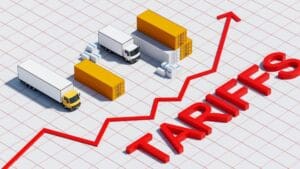The economy appears to have missed the Federal Reserve Bank memo telling it to slowdown, with today’s GDP and durable goods data exceeding expectations while initial unemployment claims point to persistent labor market tightness. The data comes just one day after Fed Chairman Powell, in typical Fed speak ambiguity, refused to speculate on if the central bank will implement another fed funds rate hike at its September meeting, but emphasized that additional rate increases may be needed depending on future economic growth and inflation. The fed funds rate is already at a target range of 5.25% to 5.5%, a 22-year high.
After establishing its 13 consecutive day of gains yesterday, the Dow Jones Industrial Index leaped this morning following news that second quarter GDP grew at an annualized seasonally-adjusted rate of 2.4% in excess of inflation, exceeding the 2% analyst consensus expectation and pointing to continued strength of consumer spending and business investment. In the aftermath of unprecedent levels of fiscal stimulus during the Covid-19 pandemic, analysts are increasingly focusing on the financial health of consumers who continue to drive economic growth. However, as stimulus savings are spent and inflation increases living costs, consumer spending could wane, challenging the soft-landing narrative.
Impressively, consumer spending during the quarter increased 1.6%, driven, at least in part, by worker wages increasing at a faster pace than inflation, according to the Commerce Department. Consumer spending on durable and non-durable goods increased 0.4% and 0.9%, respectively, during the second quarter. The increase in durable goods, which are typically purchased with debt, defied concerns that higher interest rates will cause a decline in demand for those items and some manufacturers say they are optimistic about the remainder of this year. General Motors, for example, recently upgraded its guidance, calling for full-year earnings in the range of $12 billion to $14 billion, up from its previous guidance of $11 billion to $13 billion. GM cited its pricing power and strong demand for its cars when it upgraded its outlook.
Separately, June was a strong month for durable goods, with new orders increasing 4.7% and exceeding the consensus expectation of 1.5% and May’s growth rate of 2.0%. Excluding defense, new orders increased 6.2% and transportation equipment orders increased 12.1%, the fourth-consecutive month of gains for the category. The transportation sector is benefiting from airlines upgrading their aircraft fleets.
During the second quarter, overall consumer spending increased by 1.6% with spending on services increasing 2.1%. The outlook for consumer spending appears mixed based on second-quarter earnings reports. Earlier this week, Alphabet reported its fourth consecutive quarter of disappointing advertising revenue with businesses cutting back on marketing expenses, but Facebook owner Meta reported an uptick in advertising and said its overall second-quarter revenue of $32.0 billion increased 11% year-over-year.
In his testimony yesterday following the central bank’s decision to hike the fed funds rate 25 basis points (bps), Chairman Powell explained that the Fed’s efforts to contain inflation will likely cause the labor market to soften. While Powell cited increases in both the job quit rate and labor participation against the backdrop of cooling wages as indications that the labor market is weakening, today’s data shows that employers are holding on to workers, perhaps with concerns that an extremely tight job market could make finding new employees difficult. Unemployment data underscores those concerns with 221,000 seasonally-adjusted initial claims for the week ended July 22, down by 7,000 from the prior week, much less than expected, and the third week of declines. While the news is favorable for workers as wages have recently been increasing at a faster rate than inflation, it underscores how the economy is highly resilient.
Stocks are continuing their impressive winning streak in response to solid economic data. Tech is leading the way with cyclicals looking tired as the Nasdaq Composite Index rises 1.2% while the S&P 500 is up 0.6% after reaching a fresh one-year high at 4607. Despite cyclical fatigue, however, the Dow Jones Industrial Average is looking to extend its run to 14 days, a historical record with 1987 featuring the longest winning streak of 13 days, until yesterday. Amidst a green screen, participation is mixed under the hood with cyclicals and defensives weaker as staples, utilities, financials, real estate, health care and industrials drift lower.
Bond yields depict a different story, one of caution, however. They’re rocketing higher on Powell optionality, as this morning’s data support a live September meeting. Oil and commodity prices are ripping higher, which are propping up inflation expectations and the longer end of the curve as a result. The 2- and 10-year maturities are up 10 bps each to 4.93% and 3.94%, inching closer to pivotal whole number levels at 5 and 4. The dollar is up 70 bps with its Index reaching 101.44 supported by odds of another hike at the September meeting which are firming up, with current pricing at 24%. WTI crude oil is up 1.6% to $80.03 per barrel as persistent economic growth and declining supplies in the U.S. are supportive of further upside.
Based on today’s strong economic data, investors may jump to the conclusion that a rate hike is likely in September, but doing so may be a hasty decision. Powell yesterday emphasized that when assessing monetary policy and future changes to the fed funds rate, the central bank will evaluate the totality of the economic data together with lags in monetary policy. In short, a few days of data are far short of the Fed’s pledge to review the entire economic landscape. In the meantime, commodity prices are rising and services costs continue to grow while the goods section of the economy is experiencing deflation. After sinking to a year-to-date low of approximately $64 a barrel in May, West Texas Intermediate crude oil has climbed to over $80 on a favorable supply and demand outlook with gains driven by production discipline at OPEC + and among domestic producers amidst soft landing expectations propelling the consumption outlook. Meanwhile, drought conditions in the Midwest, a port-blockade in Ukraine, and uncertainty boosted by extreme weather events and El Nino have propelled food prices this month. In another food matter, India has announced that it is expanding its ban on rice exports in an effort to control costs at home. On a positive note for fighting inflation, certain automobile companies are slashing costs, especially in the highly competitive EV market. In his second-quarter conference call, Tesla CEO Elon Musk said competition and a weakening economy may cause the company to make additional price cuts. Just a few days before then, Ford announced a $10,000 price cut for its electric pickup truck.
Today’s July forecast of 280,000 jobs added and 0.4% month-over-month increases in core and headline CPI are supportive of another hike in September, however, August’s data will be important too.
A continuation of services and commodity inflation alongside a pickup in goods prices would a nightmare for the Fed here. With a pair of Jobs and Consumer Price Index (CPI) reports arriving prior to the September decision, market players will be closely watching for clues on the Fed’s path. Today’s July forecast of 280,000 jobs added and 0.4% month-over-month increases in core and headline CPI are supportive of another hike in September; however, August’s data will be important too.
Visit Traders’ Academy to Learn about GDP and Other Economic Indicators
Disclosure: Interactive Brokers Affiliate
Information posted on IBKR Campus that is provided by third-parties does NOT constitute a recommendation that you should contract for the services of that third party. Third-party participants who contribute to IBKR Campus are independent of Interactive Brokers and Interactive Brokers does not make any representations or warranties concerning the services offered, their past or future performance, or the accuracy of the information provided by the third party. Past performance is no guarantee of future results.
This material is from IBKR Macroeconomics, an affiliate of Interactive Brokers LLC, and is being posted with its permission. The views expressed in this material are solely those of the author and/or IBKR Macroeconomics and Interactive Brokers is not endorsing or recommending any investment or trading discussed in the material. This material is not and should not be construed as an offer to buy or sell any security. It should not be construed as research or investment advice or a recommendation to buy, sell or hold any security or commodity. This material does not and is not intended to take into account the particular financial conditions, investment objectives or requirements of individual customers. Before acting on this material, you should consider whether it is suitable for your particular circumstances and, as necessary, seek professional advice.
Disclosure: Futures Trading
Futures are not suitable for all investors. The amount you may lose may be greater than your initial investment. Before trading futures, please read the CFTC Risk Disclosure. A copy and additional information are available at ibkr.com.




















Join The Conversation
For specific platform feedback and suggestions, please submit it directly to our team using these instructions.
If you have an account-specific question or concern, please reach out to Client Services.
We encourage you to look through our FAQs before posting. Your question may already be covered!